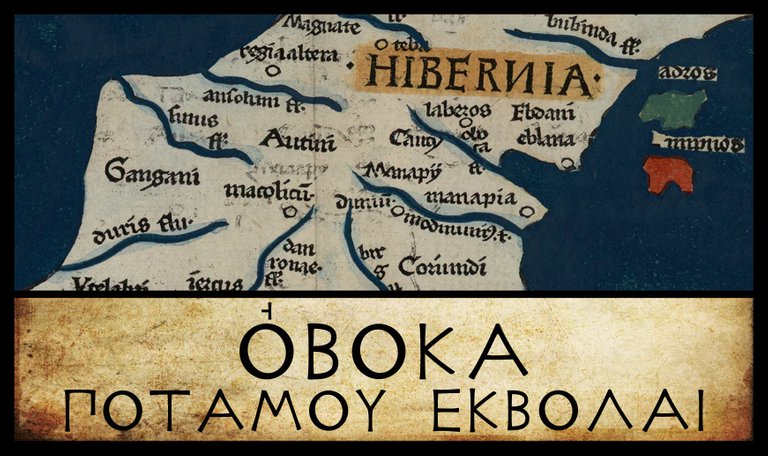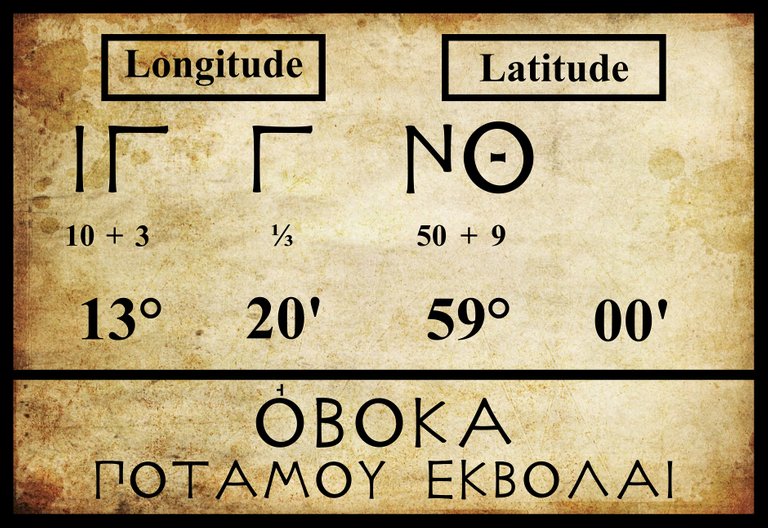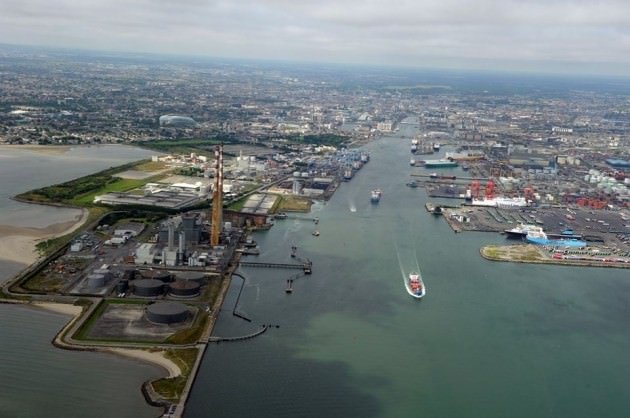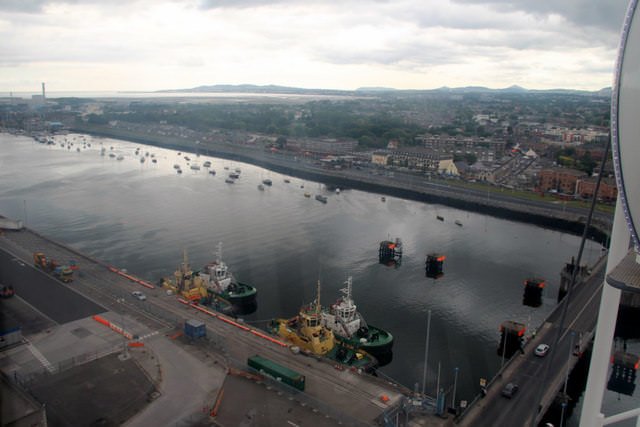
The next landmark on our tour of Claudius Ptolemy’s Geography of Ireland is Οβοκα Ποταμου Εκβολαι, or Mouth of the River Oboka. This is another of those toponyms that have left no trace in our native records. Consequently there has been much debate over the identity of this river. I have already reviewed much of the literature in the two preceding articles in this series, so there is not much more to say.
| Avoca | Liffey | Boyne |
|---|---|---|
| Camden (1607) | - | - |
| Ware (1654) | - | - |
| Orpen (1894) | - | - |
| Martin (1910) | - | - |
| Mac an Bhaird (1991-93) | - | - |
| - | - | Francis (1994) |
| - | O’Rahilly (1946) | - |
| - | Duffy (2000) | - |
| - | Darcy & Flynn (2008) | - |
Source: Darcy & Flynn 57
I have already convinced myself that the Modonnos, which Ptolemy places south of the Oboka, is the Slaney, and there is really no doubt that the Buvinda, which Ptolemy places north of the Oboka, is the Boyne. Louis Francis is the only researcher I have come across who identifies the Buvinda with any river other than the Boyne. Francis believes that Ptolemy’s coordinates imply that the Modonnos is the Liffey, the Oboka the Boyne and the Buvinda Belfast Lough at the mouth of the River Lagan. But this is to completely disregard the linguistic evidence, which puts the identity of the Buvinda and the Boyne beyond all doubt.
Between the Slaney and the Boyne, the only river of note is the Liffey, but there are many other smaller rivers that deserve some consideration. Ptolemy locates the mouth of the Buvinda 40' north of the Liffey and 90' east:

In the vicinity of Ireland, Ptolemy believed that 5' of latitude corresponded to about 7.7 km on the ground, and 5' of longitude to about 3.85 km. A simple application of Pythagoras’ Theorem puts the mouth of the Buvinda about 93 km from the mouth of the Oboka. As the crow flies, the distance between the Liffey and the Boyne is less than half this distance. The Avoca, on the other hand, is about 105 km south of the Boyne. Perhaps the Oboka is the Avoca after all!
Eblana, the coastal settlement which Ptolemy places between the Oboka and the Buvinda, is about 34 km from the latter, which accords tolerably well with Dublin’s distance. As we have seen, the old scholars were so confident that the Oboka was the Avonmore at Arklow that they renamed the latter the Ovoca. They were also so confident that Eblana was Dublin that Eblana was adopted as a Classical name for the city.
The matter will probably never be resolved with absolute certainty: it is simply unrealistic to expect one to establish infallibly the identities of landmarks whose names bear no resemblance to those in our records or in modern use. I, however, will assume that the Oboka is the Liffey and the Modonnos the Slaney. My argument is syllogistic:
Ptolemy’s description of Ireland has two rivers on the east coast south of the Buvinda.
The Buvinda is the Boyne, one of the few Ptolemaic names that are more or the less the same as their modern counterparts.
Ergo, the two rivers south of the Buvinda must be the Liffey and the Slaney, these being the only two rivers of note along this stretch of coastline.

Ptolemy’s Coordinates
Up to now, the three main editions I have been following—Müller, Wilberg and Nobbe—and the earliest and most reliable manuscript source—Vaticanus Graecus 191—have assigned the same coordinates to each of Ptolemy’s locations. But this is no longer so. In the case of the Mouth of the River Oboka, the three modern editions are at variance with the Byzantine manuscript tradition:
| Edition or Source | Longitude | Latitude |
|---|---|---|
| Müller | 13° 10' | 59° 00' |
| Wilberg | 13° 10' | 59° 00' |
| Nobbe | 13° 10' | 59° 00' |
| Vaticanus Graecus 191 | 13° 20' | 59° 00' |

The Byzantine manuscript, which is now in the Vatican Library, places the mouth of the Oboka 10' further to the east than do the later manuscripts. The discrepancy amounts to about 8 km. This manuscript, however, is thought to be of the greatest importance for the text of the Geography, because it is the only copy that is uninfluenced by the Byzantine revision (Berggren & Jones 44).

Etymology
Although the name Oboka is no longer to be found among the toponyms of modern Ireland, linguists are satisfied that it is a good Indo-European word:
Οβοκα river mouth (Oboca 2,2,8) was almost certainly the river Liffey through Dublin, not the Avoca. This name looks very like a compound of *oba ‘river (bank)’ discussed here plus the pan-European adjectival ending that led to Latin –acus, English –ic, etc. The clear implication is that Dublin people were engaged in trade at the water’s edge centuries before the Vikings arrived. (Roman Era Names)
In the article linked to the word here, Durham et al have the following to say:
Villar (2000) wrote (in Spanish) a book about place names in pre-Roman Hispania, whose chapter 4 concerns an element *uba ‘water, river’. It shows up with numerous spelling variants (upa, oba, and ovius, to name just three) in 35 ancient names from Iberia and 113 from elsewhere across Europe, and into Asia and Africa ... What determined the form this element took in different areas? How did it differ from the more familiar PIE ap-/ab- ‘water’? Did it arise from Punic speakers interacting with Indo-European speakers, sometimes suggested as the cradle of Celtic? Is it related to uper/ofer ‘bank’ and, if so, is ‘waterside, riverbank’ a better translation than ‘water, river’?
A passage from Rudolf Thurneysen’s A Grammar of Old Irish may also be relevant:
The flexion of aub oub ob (§80 b) fem. “river” is peculiar: acc. sg. abinn ... later abuinn abainn, gen. abae ... dat, pl. aibnib (Thurneysen 213)
§80 ... (b) Only before u-quality consonance is o sometimes found instead of au; e.g. ... aub “river” LL 13b7, oub Thes. II. 340, 54, ob Trip. 256, 3 etc., acc. abinn. (Thurneysen 51)
It is surely significant that one of the forms for the nominative singular of the Old Irish word for river is ob. It occurs in the Tripartite Life of Saint Patrick, as well as other sources.

References
- J Lennart Berggren, Alexander Jones, Ptolemy’s Geography: An Annotated Translation of the Theoretical Chapters, Princeton University Press, Princeton NJ (2000)
- Robert Darcy & William Flynn, Ptolemy’s Map of Ireland: A Modern Decoding, Irish Geography, Volume 41, Number 1, pp 49-69, Geographical Society of Ireland, Taylor and Francis, Routledge, Abingdon (2008)
- Karl Wilhelm Ludwig Müller (editor & translator), Klaudiou Ptolemaiou Geographike Hyphegesis (Claudii Ptolemæi Geographia), Volume 1, Alfredo Firmin Didot, Paris (1883)
- Karl Friedrich August Nobbe, Claudii Ptolemaei Geographia, Volume 2, Karl Tauchnitz, Leipzig (1845)
- Goddard H Orpen, Ptolemy’s Map of Ireland, The Journal of the Royal Society of Antiquaries of Ireland, Volume 4 (Fifth Series), Volume 24 (Consecutive Series), pp 115-128, Dublin (1894)
- Thomas F O’Rahilly, Early Irish History and Mythology, Dublin Institute for Advanced Studies, Dublin (1946, 1984)
- Claudius Ptolemaeus, Geography, Biblioteca Apostolica Vaticana, Vat Gr 191, fol 127-172 (Ireland: 138v–139r)
- Friedrich Wilhelm Wilberg, Claudii Ptolemaei Geographiae, Libri Octo: Graece et Latine ad Codicum Manu Scriptorum Fidem Edidit Frid. Guil. Wilberg, Essendiae Sumptibus et Typis G.D. Baedeker, Essen (1838)
Image Credits
- Ptolemy’s Map of Ireland: Wikimedia Commons, Nicholaus Germanus (cartographer), Public Domain
- Greek Letters: Wikimedia Commons, Future Perfect at Sunrise (artist), Public Domain
- Οβοκα Ποταμου Εκβολαι (Vaticanus Graecus 191): © Biblioteca Apostolica Vaticana, Fair Use
- The Mouth of the Liffey: © Irish Air Corps, Fair Use
- River Liffey, Dublin: Geograph Ireland, © Christine Matthews, Creative Commons License

Good job again:) Upvote for You
i learn a lot of history from you...
you are so much talented...
i like @harlotscurse @upvote @resteem done
amazing history.informative for us
very good writter.thnx for sharing my dear friend
Another informative post.
Thank you sir.
like your post.informative history
Very good written friend always with quality post congratulations you do a great job
Fantastic story friend thanks for the contribution
good article.carry on your hard jon.God bless you @harlotscurse
great..just great history.your article i like most💜
informative post dear.@upvote done
yaah..another great history.thnx @harlotscurse for your hard work
what a nice history!thnak you @harlotscurse for sharing
good story.i like your post so much.👌👌👌
Learning post. I think its very good thing. I thought everyone just post thing, not for learning. But you orove it false. Your every post is important and anyone can gain something by reading this.
Loce you buddy. Take care
Beautiful photos of your city, I really like the way you narrate the events.
Very beautiful the city of Dublin and very interesting your information.
Amazing history, educating and informative for us.
Thanks for sharing.
its ever green country in the world..its history admire me a lot..
@upvote done
its one of the great history..
thank you..@harlotsurce @upvoted & @resteemed
great history..
just love it..
@resteem done
wowowow,great history,my dear friend @harlotscurse,very good information,great writing,i love this post thanks for share,
wow
nice post
thanks for sharing
@upvoted
Another great job!
Beautiful literature. Thanks for sharing.
nice history.
@upvote done
I dont know much about you brother but i think u should write article in blogger.com. U will ne blast on that. I am sure
This is a amazing history....and really an informative post about ireland..
thanks for sharing with us dear @harlotscurse
Great story, really very best history of ireland.... I thought it was interesting how you tell and develop the story about it! great job...thanks to sharing for your good thought post.. dear....... .... friend @harlotscurse
for sharing brief history about ireland..
thanks a lot dear @harlotscurse @upvote & @resteem has dobe to present you
thanks dear for sharing this history..
for this i know something from here
@upvote @resteem done
really an informative post about ireland..
thanks for sharing with us dear @harlotscurse @resteem has done
wow,good history,my dear friend @harlotscurse,and very good information,great writing,i love this post all time,thanks for share,
wow!
thanks for sharing with us..
what an informative post about the history of ireland dear @harlotscurse @upvote & @resteem is done to present you..
wow,great post,very good history,my dear friend @harlotscurse,i love this post all time,thank you for sharing with us,
though i am new to steemit but my intersting going grew. for your post i know something about history. thanks.
@upvote & @resteem done
Indeed, this river has problems throughout history
Great information, very good writing
wow,great history,my dear friend @harlotscurse,very good information,good writing,i love this post all time,thanks for share,
wow
nice post
thanks for sharing
@upvoted